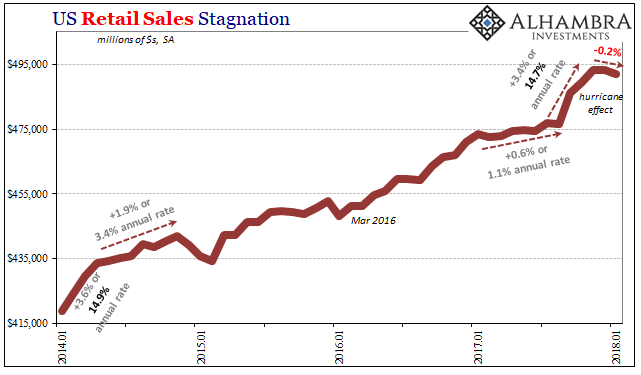Retail Sales in January 2018 rose by a little over 5% year-over-year. That followed sharp downward revisions to December, where in the biggest retail month of any calendar sales are now thought to have gained just 3.7%. Both of those rates are concerning, particularly the latter, given that almost all the gain was registered during September and October – the hurricane boost.
In seasonally-adjusted terms, retail sales declined in January after being revised to flat in December. In this view, US consumers may appear to have taken two months off from spending.
That’s not really what’s happening, of course. Rather, retail sales and a lot of other statistics captured the burst of activity triggered by the cleanup and recovery from the severe storms along the Gulf Coast in later summer 2017. In these spending figures, it was a massive 3-month gain of 3.4%. That works out to a ridiculous annual rate of 14.7%, meaning that there was no other possibility but Harvey and Irma.

In the seven months prior to September, retail sales had increased by less than 1%. That was far more consistent with especially recent estimates for income. With the labor market still on a much lower growth trajectory, incomes have been flat for several years in a row. That didn’t change with those storms, nor for any other reason.
Therefore, it was always reasonable to expect that once the temporary boost due to the anomalies had passed, consumer spending figures would revert toward their baseline; which it appears they have started to. That baseline, or what really matters, continues to be the opposite of an economic boom, especially this latest one being described as led by consumer spending. It’s just not there.
I have to wonder by just how much this inflationary boom narrative was misled by those gains in September through November (as well as in other related estimates, such as imports). That was when this description, like some of these accounts, really took off. We’ve seen it before, of course, at times like 2014 and before, but in later 2017 it became a thing.











Leave A Comment